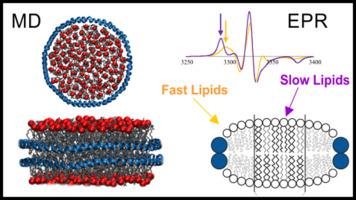Biochimica et Biophysica Acta (BBA) - Biomembranes ( IF 3.4 ) Pub Date : 2020-07-23 , DOI: 10.1016/j.bbamem.2020.183420 Piotr Stepien 1 , Bozena Augustyn 2 , Chetan Poojari 3 , Wojciech Galan 4 , Agnieszka Polit 5 , Ilpo Vattulainen 6 , Anna Wisnieska-Becker 7 , Tomasz Rog 8

|
Lipid nanodiscs are macromolecular assemblies, where a scaffold protein is wrapped around a nanosized disc of a lipid bilayer, thus protecting the hydrocarbon chains at the disc edges from unfavorable interactions with water. These nanostructures have numerous applications in, e.g., nanotechnology and pharmaceutics, and in investigations of membrane proteins. Here, we present results based on atomistic molecular dynamics simulations combined with electron paramagnetic spectroscopy measurements on the structure and dynamics of lipids in single-component nanodiscs. Our data highlight the existence of three distinctly different lipid fractions: central lipids residing in the center of a nanodisc, boundary lipids in direct contact with a scaffold protein, and intermediate lipids between these two regions. The central lipids are highly ordered and characterized by slow diffusion. In this part of the nanodisc, the membrane is the thickest and characterized by a gel-like or liquid-ordered phase, having features common to cholesterol-rich membranes. The boundary lipids in direct contact with the scaffold protein turned out to be less ordered and characterized by faster diffusion, and they remained in the liquid-disordered phase even at temperatures that were somewhat below the main phase transition temperature (Tm). The enthalpies associated with the central-boundary and central-intermediate transitions were similar to those observed for lipids going through the main phase transition. Overall, the study reveals lipid nanodiscs to be characterized by a complex internal structure, which is expected to influence membrane proteins placed in nanodiscs.
中文翻译:

看似简单的脂质纳米光盘的复杂性。
脂质纳米圆盘是大分子组装体,其中支架蛋白包裹在脂质双层的纳米尺寸圆盘周围,从而保护圆盘边缘的碳氢链免受与水的不利相互作用。这些纳米结构在例如纳米技术和药物学以及膜蛋白的研究中具有许多应用。在这里,我们介绍基于原子分子动力学模拟结合电子顺磁光谱测量结果对单组分纳米光盘中脂质的结构和动力学的结果。我们的数据强调了三个截然不同的脂质部分的存在:位于纳米圆盘中心的中央脂质,与支架蛋白直接接触的边界脂质以及这两个区域之间的中间脂质。中心脂质高度有序,并以缓慢扩散为特征。在纳米圆盘的这一部分中,膜最厚,以凝胶状或液相有序相为特征,具有富含胆固醇的膜共有的特征。与支架蛋白直接接触的边界脂质被证明具有较少的有序性,并且具有更快的扩散特征,并且即使在稍微低于主相转变温度(Tm)的温度下,它们也保留在无序液相中。与中心-边界转变和中心-中间转变有关的焓与通过主相转变的脂质所观察到的焓类似。总的来说,研究表明脂质纳米盘具有复杂的内部结构,有望影响放置在纳米盘中的膜蛋白。


























 京公网安备 11010802027423号
京公网安备 11010802027423号